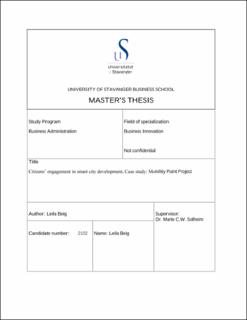| dc.description.abstract | This thesis aims at describing Stavanger city experience in citizens’ engagement for developing a mobility point in Hillevåg square, an area in Stavanger, Norway. Getting insight from existing models of citizens’ engagement in developing smart cities, and adopting a qualitative descriptive case study, I focused on finding the answer to two main questions; how citizens’ engagement has been in the mobility point project and why it is as it is. To find out various dimensions describing citizens’ participation in a smart city project, I proposed a conceptual model based on literature review and by using pattern matching technique, I explained how my finding matches, differentiates or adds to the theory. The conceptual model includes five constructs: main actors’ understanding of the project, form and level of citizens’ engagement in the project, role of citizens and activities regarding citizens’ engagement.
To find the answers to the research questions, I interviewed 12 persons, including (a) four individuals in municipality of Stavanger, (b) two individuals from private companies (c) two individuals from Kolumbus and (d) four citizens.
Findings of this research shows that Stavanger municipality and Kolumbus has been the main actors of this project who were aiming at changing the behavior of citizens towards use more public transport, use less car to reach one of the city goals which has been less Co2 emissions. For that purpose, citizens’ role has been consumer, data point, learner. Their actions include giving feedback, consume, being steered, and nudged. Although the municipality tried to involve the citizens in the project, and there is a questionnaire posted in the square that citizens can scan the barcode and share their experience, levels of citizens’ engagement has not gone further than non-participation and consumerism and barely tokenism level. When it comes to form of citizens’ participation, citizens were involved with the lowest forms of participation, choice and manipulation in which citizens have access to different options of public transport provided for them in mobility point in Hillevåg to choose from.
Some of the reasons of this combination of citizens’ engagement are, not considering citizens as one of the main actors, “to the people,” ideology rather than “with the people” ideology, unaligned understanding of the project and lack of process or structure for collaboration among different actors. | |
